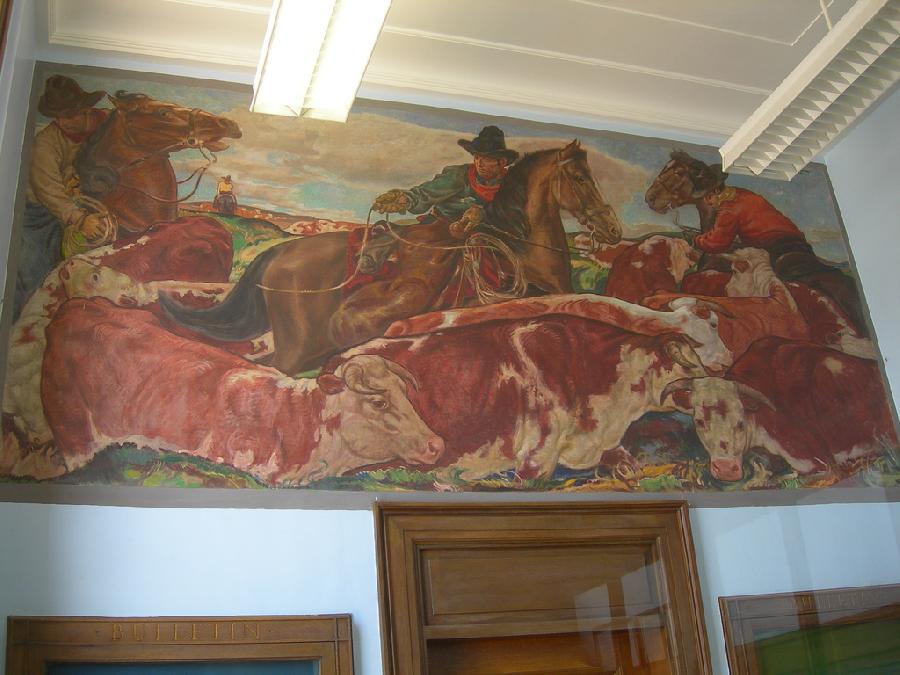Description
This is a one-story Art Deco style building with flat roof and basement. The walls are clad in a light-colored brick, but a wide course of limestone encircles the building at the tops of the walls. A large eagle and iron grille fill the space above the entrance, while slightly recessed and long, rectangular windows distinguish the front and sides of the building.
Frederick Conway’s mural, The Round-up, decorates the interior east wall and is in good condition. The post office and mural warrant further study because of their association with New Deal art.
The Round-up

by Frederick E. Conway, 1940, oil on canvas.
Conway was originally commissioned to execute a mural of grazing cattle for the Jackson, Missouri post office, but the Postmaster and local residents preferred a design by Missouri artist James B. Turnbull, who had painted a cattle-loading scene for Purcell. The Section consented to switch the commissions, and Purcell received the Conway design intended for Jackson. Unfortunately, the Postmaster of Purcell, hoping for a cattleloading scene, disapproved of Conway’s design, so the artist submitted his own interpretation of the theme upon which The Round-up is based. Conway painted the mural in St. Louis and later supervised the installation of The Round-up personally, unlike most Section artists.
As the Purcell anecdote indicates, cattle ranching scenes were often a popular choice for Oklahoma Section murals, since the occupation claimed a significant place in the state economy. Purcell was also one of the stops along the Atchison, Topeka and Santa Fe line, so cattle herds were often loaded onto railcars at the town. Conway approached the subject in a manner different than most artists by eliminating any foreground separation between the viewer and the action of cowboys and cattle. Such
intimacy makes the viewer feel the press of the herd, and the direct stare of the steer in the lower right helps to locate the viewer in the midst of the action. Whether Conway meant to insinuate the viewer into the work of the cowboys or into the controlled chaos of the herd is difficult to say, but the artist may have intended a subtle, albeit humorous association between the herding of cattle and the frustrations of standing in line at a crowded post office.
Regardless of Conway’s intent, Round-up offers a visually engaging scene that mediates between naturalistic form and a modernist sympathy for colorful pattern and spatial complexity. Cowboys and cattle alike are drawn in a representational style with heavy contours bounding each form. Conway’s use of color and careful shading also emphasizes the naturalism of Round-up; however, the markings of the cattle and their dominating presence within the image creates a play of abstract color and form throughout much of the painting. The preponderance of diagonals in the composition energizes the painting and directs the viewer’s eye in a circular motion around the perimeter of the picture plane. As such, the viewer is encouraged to perceive the painting as a decorated surface instead of a spatial extension back into three-dimensional space. This aesthetic approach allowed Conway to introduce modernist techniques while the satisfying the conservative taste for naturalism that was encouraged by the Section.
Sources
- Thematic Survey of New Deal Era Public Art in Oklahoma 2003-2004, Project Number: 03-401 (Department of Geography, Oklahoma State University).
- The Living New Deal



Recent Comments